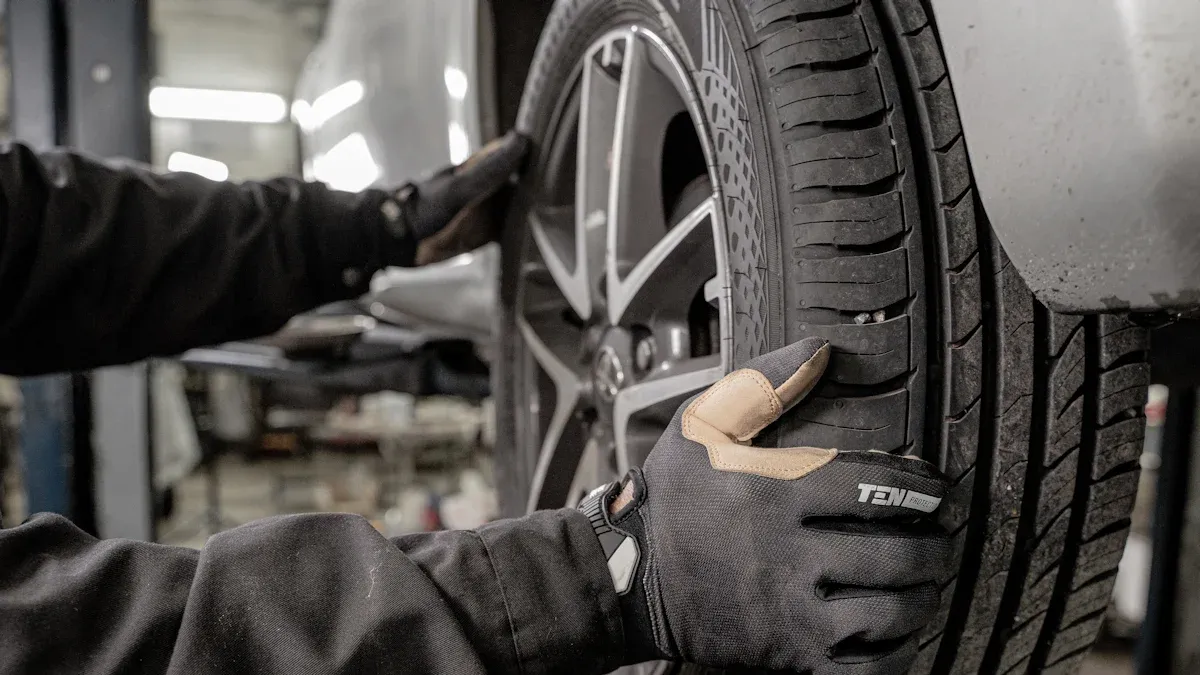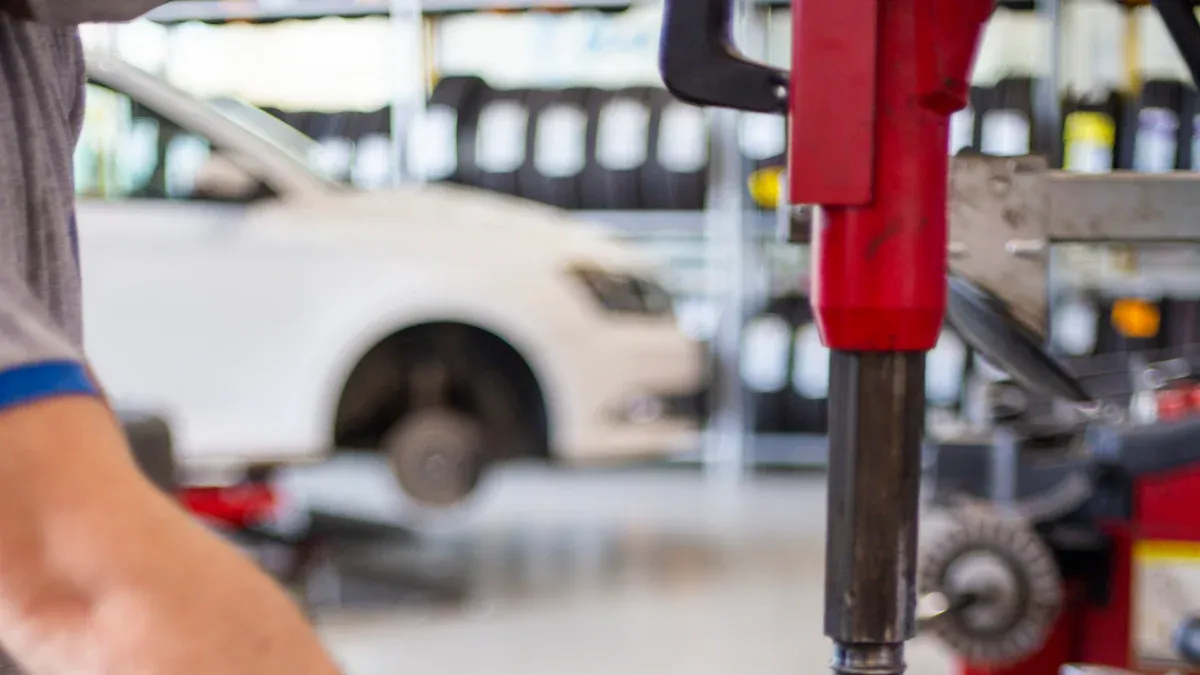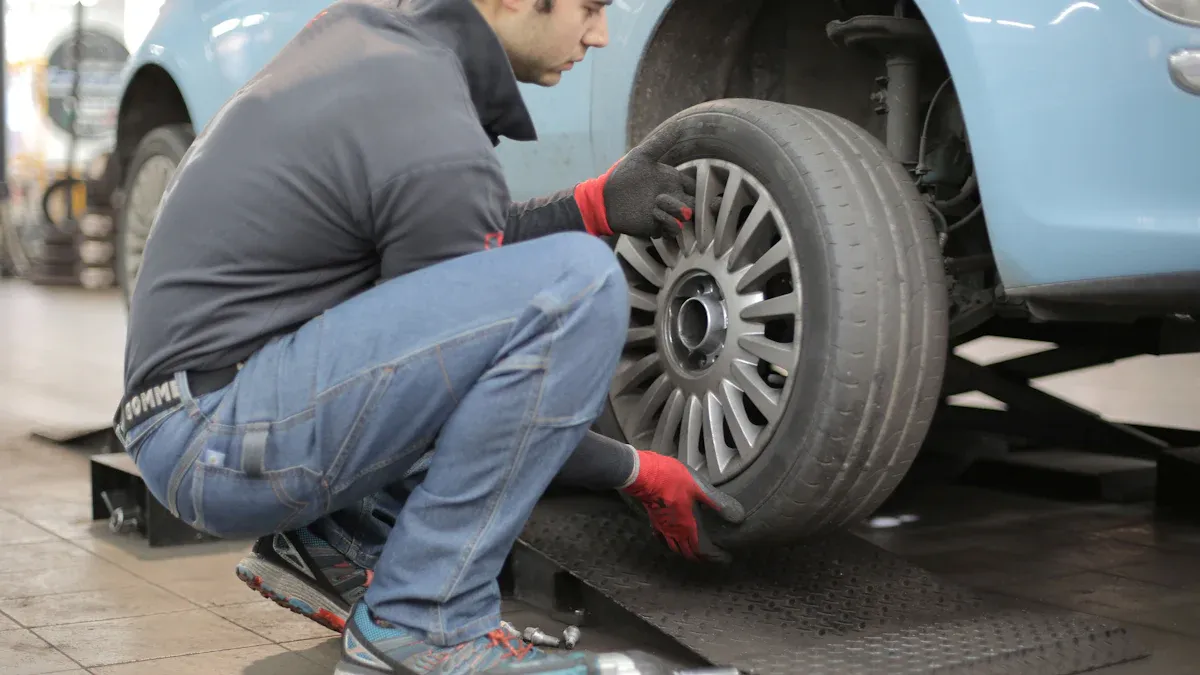

fortuneau
June 25, 2025
Balance Weight on Tire: Everything Drivers Need to Know in 2025

You need a balance weight on tire to keep your car steady and safe. Wheel weights attach to your wheels and help spread the weight evenly. This makes sure your drive stays smooth and balanced. When you use wheel weights, you lower the chance of vibrations and uneven tire wear. Drivers notice better grip, more comfort, and longer tire life. The global market for tire balance reached $1.2 billion in 2023, with growth expected as more people focus on safety and new balancing technologies.
Did you know?
- Balanced wheels help cut down on fuel use by up to 20%.
- Weights reduce tire vibrations, which means less wear and fewer repairs.
- All four tires should stay balanced for the smoothest ride.
| Performance Aspect | Key Benefit |
|---|---|
| Traction and Grip | Better tire-road contact, especially on wet roads |
| Vibration Reduction | Smoother rides, less suspension wear |
| Fuel Efficiency | Up to 20% less fuel use with balanced wheels |
Why Balance Weight on Tire Matters
Problems Caused by Unbalanced Tires
When your tires are not balanced, you may notice your steering wheel shaking or your car pulling to one side. This happens because imbalance creates uneven force distribution on your wheels. Even a small difference in weight can cause your tires to spin unevenly. You might feel vibrations in your seat or floorboard, especially at higher speeds. These vibrations can make your ride uncomfortable and noisy.
Unbalanced tires also put extra stress on your suspension and steering parts. Over time, this can lead to expensive repairs. You may see your tires wearing out faster on one side, which means you will need to replace them sooner. Many drivers do not realize that reducing vibrations helps protect your car’s parts and keeps your ride smooth.
Tip: If you notice your car vibrating or your tires wearing unevenly, schedule a tire balancing check soon.
How Imbalance Affects Driving and Tire Life
Imbalance does more than just make your drive rough. It can affect your safety and how well you control your car. The Federal Highway Administration explains that your tires play a big role in braking, steering, and rollover prevention. When your tires are not balanced, your car may not respond as quickly when you turn or stop. This can increase your risk of accidents, especially in bad weather.
Balanced tires help your car stay stable and easy to handle. Proper balancing improves traction, especially at high speeds. You get better fuel mileage because your tires roll smoothly. Tire balancing also helps your tires last longer by preventing uneven wear. Today, many cars use smart systems that monitor tire balancing in real time. These systems help you keep your tires in top shape and avoid problems before they start.
Many drivers now choose digital tire balancing and eco-friendly solutions. These new technologies make it easier to keep your tires balanced and your car safe. Regular balancing checks are a smart way to protect your investment and enjoy a smoother ride.
What Are Wheel Weights and How Do They Work?
Purpose of Wheel Weights
You may wonder why your car needs wheel weights. These small components play a big role in keeping your ride safe and smooth. Wheel weights attach to the rim of your tire. Their main job is to make sure the weight around your wheel is even. When you drive, even a tiny difference in weight can cause your tire to spin unevenly. This uneven spinning is called imbalance. If you ignore it, you will feel vibrations, hear noise, and see your tires wear out faster.
Wheel balancing weights help you avoid these problems. They keep your tires rolling smoothly by correcting any unevenness. This means you get better traction, improved handling, and a more comfortable ride. Wheel weights also protect your suspension and steering parts from extra stress. When your tires are balanced, you use less fuel and your tires last longer.
Scientific studies show that the right weight distribution improves vehicle performance and safety. For example, researchers use advanced tools like finite element analysis to test how different materials and designs affect wheels. Lighter wheels made from strong materials, such as aluminum or carbon fiber, reduce stress and improve how your car handles. Wheel weights work with these designs to keep everything balanced and safe.
Note: Wheel balancing weights are not just for regular cars. Electric vehicles also use special counterweights to balance the heavy batteries. This helps keep the car stable and easy to control.
How Wheel Weights Correct Imbalance
When you visit a tire shop, technicians use special machines to check your tires for imbalance. These machines spin your tire at high speeds, just like when you drive on the road. Sensors measure where the tire is heavier or lighter. The machine then tells the technician exactly where to place the wheel weights.
Recent research by Mitsubishi Heavy Industries Machinery Systems shows how advanced these machines have become. Their dynamic balance machines use three-dimensional sensors to find even the smallest imbalance, as little as 1 gram. The machine can measure and correct each tire in just 17 seconds. This high level of accuracy means your tires get the best possible balance.
You will find two main types of wheel weights: clip-on and adhesive. Clip-on weights snap onto the rim, while adhesive weights stick to the inside of the wheel. Both types help fix imbalance by adding just the right amount of weight where it is needed. Digital wheel balancers use sensors and software to make sure the weights go in the perfect spot. This technology helps you get a smoother ride, better fuel efficiency, and longer tire life.
- Wheel weights ensure even weight distribution around the wheel and tire assembly.
- Digital wheel balancers detect imbalances precisely, allowing for accurate corrections.
- Concrete counterweights in electric vehicles help balance heavy battery packs, improving vehicle stability and safety.
Wheel balancing is important for all types of vehicles. It helps prevent vibrations, uneven tire wear, and poor handling. When you use balance weight on tire, you protect your car and make every drive safer. Wheel balancing weights are a simple but powerful way to keep your vehicle running at its best.
| Wheel Weight Function | Benefit to You |
|---|---|
| Corrects tire imbalance | Reduces vibrations and noise |
| Improves weight distribution | Enhances handling and safety |
| Extends tire life | Saves money on replacements |
| Boosts fuel efficiency | Lowers your fuel costs |
Tip: Schedule regular wheel balancing checks. This keeps your tires in top shape and helps you avoid costly repairs.
Types of Wheel Balancing Weights

When you balance your tires, you have several types of wheel weights to choose from. Each type works best for certain wheels and driving needs. Knowing the differences helps you pick the right wheel balancing weights for your vehicle.
Clip-On Wheel Weights
Clip-on wheel weights use a metal clip to attach directly to the rim. You often see these weights on steel wheels. They stay secure even when you drive on rough roads. Many commercial vehicles use clip-on weights because they are quick to install and cost-effective. These weights help keep your tires stable and reduce uneven tire wear.
Clip-on weights work best for steel rims and standard vehicles. They offer strong attachment and help your tires last longer.
Here is a comparison of clip-on and adhesive wheel weights:
| Feature | Clip-On Wheel Weights | Adhesive Wheel Weights |
|---|---|---|
| Installation Method | Uses a clip mechanism for attachment | Uses adhesive backing for attachment |
| Best Suited For | Steel rims | Alloy wheels |
| Key Benefits | Cost-effective, enhances stability, reduces tire wear | Aesthetic appeal, precise placement, advanced durability |
| Popular Applications | Standard vehicles | High-performance and luxury vehicles |
Adhesive (Stick-On) Wheel Weights
Adhesive wheel weights, also called stick-on weights, use a strong sticky backing to attach to the inside of the rim. You often use these weights on alloy wheels or high-performance cars. They do not damage the rim’s finish and stay hidden for a clean look. Adhesive wheel weights allow for precise placement, which helps you achieve perfect balancing.
Many tire shops choose adhesive wheel weights for luxury and sports cars. These weights work well for larger tires and wheels that need extra care. You get better balance and less vibration when you use adhesive wheel weights on the right rims.
Eco-Friendly Wheel Weights
Eco-friendly wheel weights use materials like steel or zinc instead of lead. These weights help protect the environment and meet strict regulations. Steel and zinc do not pollute the soil or water, and they resist rust and corrosion. Many countries now ban lead wheel weights because they harm the environment.
- The US Environmental Protection Agency reports that 1.6 million pounds of lead wheel weights fall off cars each year, causing pollution.
- About 70% of EU countries have banned lead-based wheel weights.
- Tire shops now use more steel and zinc weights to keep up with safety and environmental rules.
Eco-friendly wheel weights offer strong performance. Steel weights last a long time and cost less. Zinc weights resist rust, which helps in wet climates. Electric and hybrid vehicles also need precise balancing, so these lead-free weights are a smart choice.
Tip: Choose eco-friendly wheel weights to help the planet and keep your car safe.
Signs Your Tires Need Wheel Weights

Common Symptoms While Driving
You can spot early signs you need wheel balancing by paying attention to how your car feels on the road. Vibrations or shaking in the steering wheel often start when you reach speeds of 40 to 50 mph. These vibrations can get worse as you drive faster. Sometimes, you may feel the whole car shake or notice a wobbling sensation. This happens because the tire does not spin evenly, which causes the wheel weights to lose their effect.
Other symptoms include bouncing or a thumping noise from the tires. If you see uneven tread wear, especially diagonal patterns or tread depth differences greater than 1/16 inch, your tires may be out of balance. You might also notice your car pulling to one side or your fuel economy dropping. Unbalanced tires make your engine work harder, which can increase fuel use by 1% to 2%. Advanced wheel weights now reduce vibration by up to 60%, making your ride much smoother.
🚗 Tip: If you feel vibrations or see uneven tire wear, check your wheels for missing weights or debris stuck in the rim.
When to Check for Tire Imbalance
You should check for tire imbalance at certain times to keep your car safe and comfortable. Re-balancing is a good idea when your tires reach about 50% wear. Tires worn more than halfway often lose their original balance, especially if you have not rebalanced them since installation. After hitting a pothole or curb, inspect your wheels for missing weights or damage.
Visual checks help too. Look for missing wheel weights or dirt on the rim. If you notice tread wear patterns or your car starts to bounce, schedule a balancing check. Wheel balancing equipment today can measure imbalance down to tenths of a gram, so technicians can fix even small problems. Regular balancing keeps your tires in top shape and improves handling.
| When to Check for Imbalance | What to Look For |
|---|---|
| After 50% tire wear | Uneven tread, more vibrations |
| After hitting potholes or curbs | Missing weights, rim damage |
| During regular tire rotations | Bouncing, wobbling, noise |
Staying alert to these signs helps you catch problems early. Proper wheel weights and regular balancing protect your tires, save money, and keep your ride smooth.
Installing Wheel Weights: DIY or Professional?
DIY vs. Professional Installation
You might wonder if you can install wheel weights at home. Some drivers try to balance their own tires using basic tools. You can buy stick-on or clip-on weights at auto parts stores. These kits often come with instructions and a small hammer. If you have experience with car repairs, you may feel confident trying this method.
However, most experts recommend professional wheel balancing. Tire shops use advanced machines that spin your wheels and measure tiny differences in weight. These machines can detect imbalances as small as one gram. Technicians know exactly where to place the weights for the best results. You get a smoother ride and better tire life when you let a pro handle the job.
Tip: If you want the most accurate balance, choose professional wheel balancing. Shops use digital equipment that gives you precise results every time.
| Method | Tools Needed | Accuracy Level | Best For |
|---|---|---|---|
| DIY | Hammer, weights | Low to Medium | Simple fixes, experience |
| Professional | Digital balancer | High | All drivers, new tires |
Safety and Accuracy Considerations
Safety should always come first when you install wheel weights. If you place weights in the wrong spot, your tires may vibrate or wear out faster. Poorly balanced tires can make your car harder to control, especially at high speeds. You risk losing optimal handling if the balance is off.
Professional shops use machines that check each wheel for balance. These machines help ensure your car stays safe on the road. You also protect your suspension and steering parts from extra stress. Accurate balancing means you get the best performance and safety from your tires.
⚠️ Note: Always check your wheels after hitting a pothole or curb. Even small impacts can knock weights loose and affect your car’s handling.
Choosing professional wheel balancing gives you peace of mind. You know your tires are balanced for safety, comfort, and long life.
Using a balance weight on tire gives you many benefits. You enjoy a smooth and balanced ride, better fuel efficiency, and longer-lasting tires. Regular wheel balancing checks help you spot problems early. In 2025, new balancing technology makes these checks faster and more accurate. Experts recommend checking your wheels every 6,000 miles or after hitting a pothole. Stay safe and comfortable—schedule your next tire balance check today!
FAQ
How often should you balance your tires?
You should balance your tires every 6,000 miles or when you notice vibrations. Regular checks help your tires last longer and keep your ride smooth. Many experts recommend balancing during every tire rotation.
Can unbalanced tires affect fuel efficiency?
Yes, unbalanced tires make your engine work harder. You may use up to 20% more fuel if your wheels are not balanced. Balanced tires help you save money at the pump.
Are eco-friendly wheel weights as effective as traditional ones?
Eco-friendly wheel weights made from steel or zinc work just as well as lead weights. They meet strict safety standards and protect the environment. Many countries now require these safer materials.
What happens if you ignore tire imbalance?
Ignoring tire imbalance leads to vibrations, uneven tire wear, and possible damage to your suspension. You may also notice poor handling and higher repair costs. Always address imbalance quickly to stay safe.
Can you reuse wheel weights after removing them?
Most wheel weights lose their grip or adhesive after removal. You should use new weights for the best balance and safety. Reusing old weights may cause them to fall off while driving.





